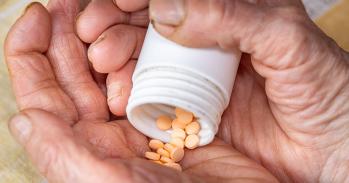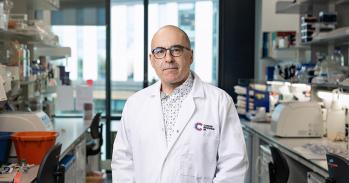
New study describes a fundamental mechanism regulating a protein’s shape and function, with potential applications in biotechnology and drug development.
New study describes a fundamental mechanism regulating a protein’s shape and function, with potential applications in biotechnology and drug development.
The power of such multi-disciplinary studies is that we can begin to answer questions that neither of us could do alone
Jane Clarke
New research has identified a fundamental mechanism for controlling protein function. Published today (18 December) in the journal Science, the discovery has wide-ranging implications for biotechnology and medicine.
The shape of a protein determines its function, for example whether it is able to interact with another protein or with a drug. But a protein’s shape is not constant – it may change in response to different conditions, or simply as a matter of course. Understanding how this process works is key to figuring out how to manipulate proteins, for example in order to disrupt a disease.
The researchers looked at a family of bacterial RNA-binding proteins that control a basic process in metabolism: one type of bacteria lives in very high temperatures, while the other likes things colder. The goal was to determine how a protein morphs from an active configuration (one that lets it bind to RNA) to an inactive one in two very different environments.
“The process is controlled by mutations, but these mutations aren’t in an obvious place, where the binding happens,” explains Sarah Teichmann, of the European Bioinformatics Institute (EMBL-EBI), who led the research. “They’re actually working from a distance, indirectly, to change the shape of those sites. We wanted to know how that works at an atomic level.”
“Any stable protein will have a lot of constraints on its mutational pathways,” said Tina Perica of EMBL-EBI, the paper’s lead author. “These mutations have very few options – just like a person walking along a cliff will need to keep to a narrow path. But at the same time, proteins need enough wiggle room to be able to bind to things, like another protein or a drug. To find where the protein could provide that wiggle room, we retraced its steps millions of years into the past, and used a lot of different approaches to figure out what was happening.”
The work was a collaboration between Professor Jane Clarke’s biophysics lab in Cambridge’s Department of Chemistry, and Teichmann’s structure genomics protein evaluation lab. “The power of such multi-disciplinary studies is that we can begin to answer questions that neither of us could do alone,” said Clarke.
“If you know how a species of bacteria has evolved, you can reconstruct proteins that it may have had in the past, but which don’t exist today,” says Yasushi Kondo from MRC Laboratory of Molecular Biology. “We made a couple of these proteins, and used X-ray crystallography to solve their structures. That let us see details we would never have seen if we’d only studied proteins from the bacteria that live today. When we put that new information together with computational work and simulations, we started to see a clear picture of how these proteins change.”
“These proteins provide a very good example of a fundamental biophysical phenomenon that we think can happen in many proteins, regardless of which organism,” said Teichmann. “We believe our findings will help future research into manipulating proteins, which has potential applications across the life sciences.”
Adapted from EMBL-EBI press release.
The text in this work is licensed under a Creative Commons Licence. If you use this content on your site please link back to this page. For image rights, please see the credits associated with each individual image.





